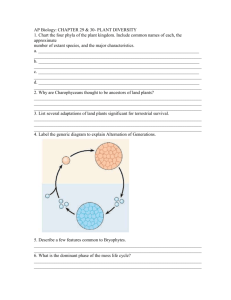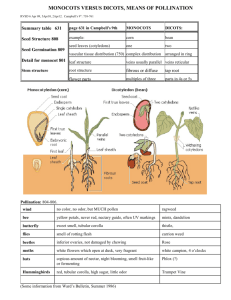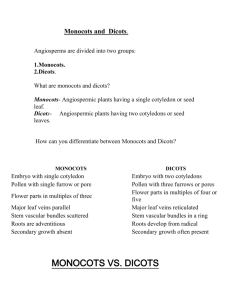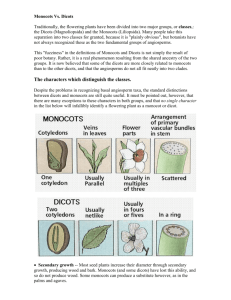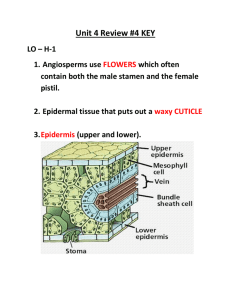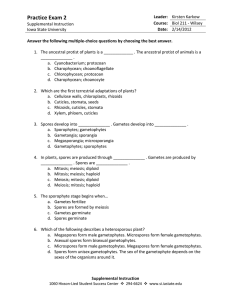Honors biology plants What is a Plant? Multicelled Eukaryote
advertisement
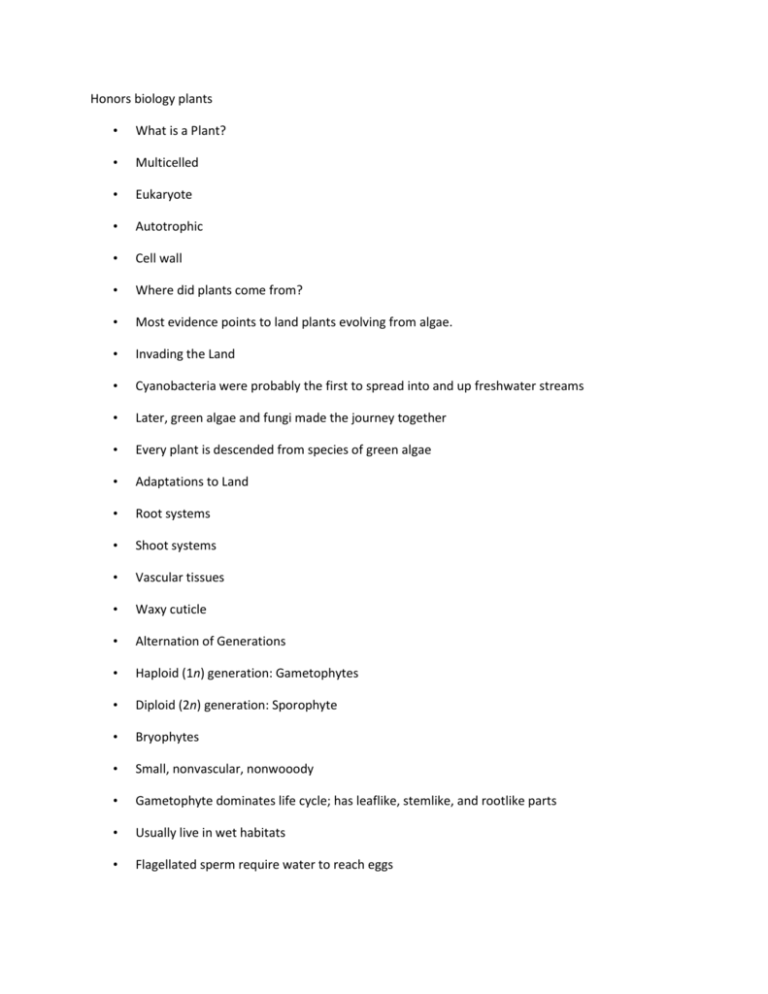
Honors biology plants • What is a Plant? • Multicelled • Eukaryote • Autotrophic • Cell wall • Where did plants come from? • Most evidence points to land plants evolving from algae. • Invading the Land • Cyanobacteria were probably the first to spread into and up freshwater streams • Later, green algae and fungi made the journey together • Every plant is descended from species of green algae • Adaptations to Land • Root systems • Shoot systems • Vascular tissues • Waxy cuticle • Alternation of Generations • Haploid (1n) generation: Gametophytes • Diploid (2n) generation: Sporophyte • Bryophytes • Small, nonvascular, nonwooody • Gametophyte dominates life cycle; has leaflike, stemlike, and rootlike parts • Usually live in wet habitats • Flagellated sperm require water to reach eggs • Types of Bryophytes Mosses (most common) Liverworts (simplest) Hornworts • Pteridophyte • Like bryophytes • – Live in wet, humid places – Require water for fertilization Unlike bryophytes – Sporophyte is free-living and has vascular tissues • Traits of Seed-Bearing Plants • Pollen grains • – Develop into male gametophytes – Can be transported without water Seeds – Embryo sporophyte inside nutritive tissues and a protective coat – Can withstand hostile conditions • Gymnosperms • Plants with “naked seeds” • Seeds don’t form inside an ovary • Four groups Conifers Cycads • Ginkgos Gnetophytes Pine Cones • Woody scales of a “pine cone” are the parts where megaspores formed and developed into female gametophytes • Male cones, where microspores and pollen are produced, are not woody • Angiosperms • Flowering plants • Dominant land plants (260,000 species) • Ovules and (after fertilization) seeds are enclosed in an ovary • Three main groups: magnoliids, monocots, and eudicots • Fruit • Simple fruit: Single fruit from a single ovary (apple, cherry, soybean) • Aggregate fruit: Single flower with multiple carples (blackberry) • Multiple fruit: Multiple flowers fuse together to form one fruit (pineapple) • Monocots & Dicots • Cotyledons: Embryonic leaves • Monocots: 1 embryonic leaf • Dicots: 2 embryonic leaves • Monocots • One cotyledon • Parallel veins in leaves • Vascular bundles • Flower parts in 3’s • Fibrous roots • Dicots • 2 cotyledons • Veins usually branched • Vascular bundles in rings • Flower parts in 4 or 5’s • Taproot • Sexual Life Cycle of Flowering Plants • Sepal: usually green, look like leaves • Stamen: Male reproductive organs • Anther: Tip of stamen were pollen is • Carpel: Female reproductive organ • Stigma: Receiving surface for pollen • Ovary: Base of carpel that stores ovule • Ovule: Contains developing egg • Double Fertilization • Distinctive feature of angiosperms • Male gametocyte delivers two sperm to an ovule • One fertilizes egg; other fertilizes a cell that gives rise to endosperm • Seed Dispersal • Wind blown • Animal carried (external) • Animal carried (internal) • Seed Development • Endosperm: Nutrient-rich multicellular mass that nourishes embryo • Seed coat: Ovule’s coat that has lost water that encloses embryo and endosperm • Seed dormancy: A period when the embryo stops developing until environmental conditions are right • Seed Germination • Asexual Reproduction • Vegetative reproduction: Fragmentation of plant parts growing into new plants • Also known as vegetative propagation • Bulbs • Shoots and Roots • Shoots • – Produce food by photosynthesis – Carry out reproductive functions Roots – Anchor the plant – Penetrate the soil and absorb water and dissolved minerals – Store food • Angiosperm Body Plan • Ground tissue system • Vascular tissue system • Dermal tissue system • Complex Tissues Composed of a mix of cell types Xylem Phloem Epidermis • Simple Tissues Made up of only one type of cell Parenchyma Collenchyma Sclerenchyma • Parenchyma: A Simple Tissue • Most of a plant’s soft primary growth • Pliable, thin walled, many sided cells • Cells remain alive at maturity and retain capacity to divide • Mesophyll is a type that contains chloroplasts • Collenchyma: A Simple Tissue • Specialized for support for primary tissues • Makes stems strong but pliable • Cells are elongated • Walls thickened with pectin • Alive at maturity • Sclerenchyma: A Simple Tissue • Supports mature plant parts • Protects many seeds • Thick, lignified walls • Dead at maturity • Two types: – Fibers: Long, tapered cells – Sclereids: Stubbier cells • Meristems • Regions where cell divisions produce plant growth • Apical meristems • – Lengthen stems and roots – Responsible for primary growth Lateral meristems – Increase width of stems – Responsible for secondary growth • Mesophyll: Photosynthetic Tissue • A type of parenchyma tissue • Cells have chloroplasts • Two layers in dicots – Palisade mesophyll – Spongy mesophyll • Acquisition of Nutrients • Plants take in CO2 through the leaves and water and Minerals (inorganic ions) through the roots. • Nitrogen, phosphorus, and magnesium • Root Hairs • Extensions from the root epidermis • Greatly increase the surface area available for absorption • Transpiration • Transpiration: The pulling force from water loss through the leaves • Root pressure: Water enters the roots through osmosis and pushes the xylem sap up a few meters. • Cohesion tension: The sticking together of water molecules to each other and to the cellulose molecules of the xylem • Stomata • The cells around the stomata • Guard cells can close or open depending on the temperature • They control the amount of water loss through the leaves and the amount of CO2 entering • Carnivorous Plants • Capture animals to supplement their nutrient intake • Venus flytrap lures insects with sugary bait; closes on victim • Cobra lily lures insects down a one-way passage • Epiphyte & Parasites • Epiphytes: Live on other plants but do not take nutrients from host plant (Spanish moss) • Parasites: Live on other plants and do take nutrients form host plant (mistletoe) • Plant Hormones Auxin Cytokinins Gibberellins Abscisic acid Ethylene • Plant Hormones • Auxins: Stimulate stem elongation, branching, apical dominance • Gibberellins: Promote seed and bud germination, stem elongation, leaf growth, apical root growth • Abscisic acid: Inhibits growth, closes stomata during water loss, helps maintain dormancy • Tropism • Tropism: Growth response caused by a stimulus • Phototropism: Response towards light • Gravitropism: Response to gravity
